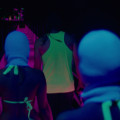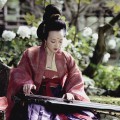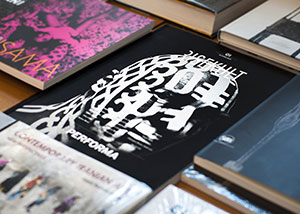Hana-bi o “fiori di fuoco” racchiude due opposti in un’alternanza tra violenza e dolcezza, realtà apparentemente antitetiche ma nel senso assoluto della storia rappresentano un incontro vicino e complementare. Il colore rosso, predomina per quasi tutto il film, quel sangue sporco che si dissolve in un dipinto di paesaggi come la storia di Horibe (uno dei personaggi) che dopo un tragico incidente ritroverà il senso della vita nella pittura, un richiamo alla pace interiore acquisito dallo stesso Kitano in passato, dopo un incidente in moto nel 1994. Tutte le tavole presenti nel film sono state realizzate dallo stesso regista. Il disegno sarà quindi fondamentale per esternare questo tipo di serenità e per scandire una nuova rinascita del suo stile cinematografico, un fiore che nasce dal fuoco appunto. Un’atmosfera totalmente inedita per lo yakuza movie caratteristico per le sue sparatorie, questa volta con qualcosa di più profondo e distante dalle precedenti opere (“Violent Cop” e “Sonatine”). Quella di Hana-bi è una storia catartica dove non esiste violenza finalizzata al bene comune o all’ideale, ma fine a se stessa e il sangue non è più solo sinonimo di giustizia o regolamento di conti, prevarrà anche un senso di dolcezza in un’atmosfera di immagini meravigliose e delicate, come la moglie malata terminale del protagonista Nishi (interpretato dallo stesso Kitano) fondamentale per esprimere questo sentire. Il finale ci fa comprendere la complementarietà fra questi due elementi -fuoco e sangue- e l’assoluto bisogno di rigoroso silenzio che scandisce un rapporto tra gesti, sguardi e giochi. L’emblematica scena dove i due giocano in una macchina ad indovinare le carte, con tanto di inquadratura riflessa sullo specchietto retrovisore, rappresenta un altro elemento cardine del film, il gioco. Nonostante tutto nessun momento è eccessivamente tragico per non lasciarsi trasportare dall’emozione e dall’amore. L’ultima scena della bambina e l’aquilone è di una bellezza nostalgica, fra sorrisi e giochi ma dal tragico epilogo, raccorda tutto in un solo significativo sguardo verso il mare. Il film è stato presentato in anteprima al festival di Venezia il 3 settembre 1997 aggiudicandosi il Leone D’oro, di fatto consacrando Takeshi Kitano sulla scena internazionale.
Hana-bi, or “fire flowers” contains two opposite alternating between violence and gentleness, actually seemingly antithetical but in the absolute sense of history represent a close encounter and complementary. Red, predominates for most of the film, that dirty blood dissolving in a painting of landscapes such as the story of Horibe (one of the characters) that after a tragic accident found the meaning of life in the painting, a call to inner peace acquired by Kitano in the past, after a motorcycle accident in 1994. All of the tables in the film were made by the director himself. The design will be so critical to outsource this kind of serenity and to mark a new revival of his cinematic style, indeed a flower that comes from fire. A totally unprecedented for the yakuza movie characterized by its shootings, this time with something deeper and far from previous works ( “Violent Cop” and “Sonatine”). That of Hana-bi is a cathartic story where there is violence for the common good or ideal, but an end in itself and the blood is no longer just synonymous with justice or showdown, also prevails a sense of sweetness in an atmosphere of wonderful and delicate images such as protagonist Nishi’s wife terminal patient (Nishi is played by Kitano himself) critical to express this feeling. The end makes us understand the complementarity between the two elements -Fire and blood- and the absolute need for strict silence that marks a relationship between gestures, glances and games. The emblematic scene where the two actors play to guess the cards in a car, complete with a frame reflected on the rearview mirror, it is another key element of the film, the game. Despite everything no time is too tragic to not be carried away by emotion and love. The last scene of the child and the kite is of a nostalgic beauty, between smiles and games, but with a tragic epilogue, connecting all in one meaningful look toward the sea. The film was prized at the Venice Film Festival September 3, 1997, winning the Golden Lion, in fact consecrating Takeshi Kitano on the international scene.





























